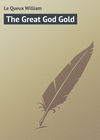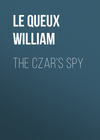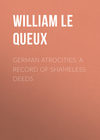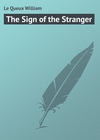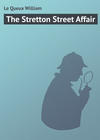Читать книгу: «The Great God Gold», страница 11
Chapter Twenty Two
Increases the Mystery
The morning was foggy, damp and dark in London, one of those to which dwellers in the Metropolis are so accustomed in the short December days.
In “Red Mullet’s” sitting-room off Oxford Street – that same room in which Gwen Griffin had endured her imprisonment – he and Doctor Diamond were seated.
A fortnight had passed since the red-haired man’s visit to Horsford, but in accordance with a promise made he had, late the previous evening, telegraphed to the hunchback, and in response to the message the latter had left Peterborough by the up-express at nine o’clock that morning.
“Well, Doc,” the tall man was saying as he lay stretched lazily in his chair smoking a cigarette. “I’m giving away my friend in order to oblige you, and I’ve had a lot of difficulty, as you may imagine. My friends are a pretty tough crowd, as you know. But I’ve fulfilled the promise I made to you, and all will be well providing that young lady, Miss Griffin, only holds her tongue.”
“Then you’ve really obtained a copy of the document for me – eh!” interrupted the ugly little man, his face brightening quickly.
“Yes. I was very nearly caught in the act of taking it. It was kept in a safe, and I had to get hold of the key by a ruse. I kept it a day, and got a typed copy made. Then I retained it to its place.”
“By Jove, Mr Mullet, you’re a real friend!” cried the Doctor, starting up. “As you know, we’ve been handicapped hitherto by not knowing the context of the document. Ours has been all guesswork.”
“Well, it needn’t be any more,” remarked the red-haired man with a light laugh, “for here’s a complete copy. You’d better read it out. It’s a very remarkable statement.” And he produced a typewritten manuscript which the Doctor, after clearing his throat, eagerly read as follows:
“THE TREASURE OF ISRAEL.
“Revealed by a Hebrew Cipher in the Old Testament.
“I, Peter Holmboe, graduate of Helsingfors University, in Finland, late Professor of Hebrew at St. Petersburg University, and now resident at Langenfelder Strasse, 17, Altona, Germany, make oath and declare as follows:
“Curious, and perhaps improbable as it may at first appear, I claim to have discovered the actual whereabouts of the hidden treasure of the Jewish Temple, which includes among other things the Ark of the Covenant, the Tablets of moses, and the enormous treasure of gold and silver known to exist before the capture of Jerusalem by Nebuchadnezzar, King of Babylon.
“The Secret.
“The secret of the place of concealment is contained in a cipher which runs through certain chapters of the Book of Ezekiel, and which clearly relates the whole story and gives absolute and most complete directions with measurements by which the spot is indicated. And not only this. The same story, in a much more abbreviated form, is, curiously enough, also repeated in the same cipher in certain chapters of Deuteronomy.
“It is a historical fact that when Nebuchadnezzar seized Jerusalem nearly the whole of the treasure of the Temple had disappeared, and it would seem that into the Book of Ezekiel the secret was incorporated, so that the treasure, which formed the war-chest of the Jews, could be recovered at the coming of the Messiah.
“Many points are, of course, highly interesting and curious. Perhaps my discovery – which, by the way, was by pure accident – will create much controversy and arouse great excitement among scholars and archaeologists. Nevertheless the cipher exists, as I am ready, under certain conditions and on certain financial considerations, to indicate its existence to any competent Hebrew scholar who may be appointed to investigate my discovery.
“The Cipher.
“For many years I had been greatly interested in the various astronomical, astrological and cabalistical signs and cycles so apparent in the chronology of the ancient peoples. In the Bible, and more especially during the five hundred or so years before Christ, I found evidences of the astrology that was used in the division of time, and therefore set to work, using the comparing method in order to obtain an insight into the different ciphers most universally used, and also into the methods of concealing secret messages and statements. Many of the ciphers used were highly ingenious and most difficult to decipher. The Jews in Jerusalem used them, so did the Jewish Greeks in Alexandria and the Buddhists in India, as well as the Gnostics, etc.
“I had been studying certain curious expressions in the ‘Mischna,’ which seemed to me to contain certain hidden meanings, when one day, in studying the Book of Ezekiel in the original, I was amazed to come across an expression which, habituated as I was to the presence of ciphers, told me at once that a hidden message was contained there.
“After countless failures through several years, I one day applied one of the earlier known cabalistic ciphers – which, by the way, is so complicated and ingenious that the whole message must be deciphered before the first word becomes apparent – and, to my intense astonishment, on making the complete decipher I found myself able to read a clean declaration (extending through nine chapters) of the secret hiding-place of the Great Treasure of Israel!
“The cipher declaration opens with an intimation of 490 years before the arrival of the Messiah, and continues as follows:
”‘The lapse of years are nearing its filling. The relief of the Doom will come in spite of all. The people’s right is nearing. The Period of the Blood-Debts and that of the Suppression will lose its power.’
“It is then stated that Moses’ tablets, the archives of the Temple, the Ark of the Covenant and ‘the Chair of Grace between two cherubims of fine gold,’ ‘the insignias Urim and Thummim with two rubies of extraordinary size surrounded by a multitude of other precious stones,’ the ‘written archives of the earliest period of the Jews’ till about B.C. 600, ‘the great treasures of the Temple, gold and silver vessels, coined gold, and precious stones of every description’ were all ‘concealed beneath the earth in a dry-room in connection with which is a series of water-tunnels.’
“The secret declaration goes on to give the most complete details of how the treasure may be reached. It is stated that there are three entrances, one of which is impossible as it is inaccessible, being closed up by masonry in a labyrinth of caves; the second is also too difficult. But the third is accessible by draining the water and will not present much difficulty.
“The cipher continuing, declares:
”‘The tablets shall remain in their hiding-place till the arrival of the Messiah, who alone may open their place of concealment, in order that He may furnish proof of the faith, and if necessary the treasure shall provide a war fund when the Messiah conquers the world and establishes his residence in Jerusalem.’
“The cipher concludes by declaring:
”‘Six curses, yea! sixty times six curses, shall be upon the head of any one who dare to attempt to violate the treasure-house.’
“That the messages, each identical, run through both Ezekiel and Deuteronomy is indisputable, and I am quite ready to explain them, provided my secret is properly protected.
“Among the many curious and interesting features which go far to prove that the treasure is still lying undisturbed, I may perhaps indicate the Biblical fact that, after the Babylonian imprisonment, the tablets of Moses were never again exhibited in the Temple. Yet did not Nehemiah convince himself that they were intact and in good condition?
“We know that Nebuchadnezzar received certain vessels from the Temple at Jerusalem (Ezra, i, 7-11) but no mention is made of the tablets, of the Ark, or of any other of the things mentioned in the cipher!
“Again, when Titus destroyed Jerusalem he did not obtain the Ark. On the Arch of Triumph still existing in Rome are representations of the candlesticks, but there is no representation of the Ark.
“Through the whole prophecy of Ezekiel I can point out many evidences of the existence of the treasure.
“And, finally, it is extremely curious that the Crusaders searched actively for it, but mostly in the neighbourhood of Engeddin.
“Whether the treasure of Israel still exists or not, the cipher declaration stands out in black and white, one of the best known and most difficult of all the various modes used by the ancients for concealing messages.
“I claim that it is a most amazing discovery which must be of deepest interest to the whole civilised world, and should be at once investigated. I have not, of course, space to give complete Biblical references, etc. These I will supply later on, if necessary.
“Any Jew who may be consulted will no doubt scorn the idea of the existence of the treasure. He will do so because he will argue that no cipher can exist in a book inspired. Again, he may declare that all the treasure was all carried off to Babylon. This is, I maintain, disproved by historical facts.
“Again, there may be considerable argument as to whether the Books of Ezekiel and of Deuteronomy were written about the same period. According to the latest theory, Deuteronomy was written before Ezekiel, nevertheless this discovery of the same cipher record in both now conclusively proves that they were written at very nearly the same time.
“Further, I am aware of the Talmudic tradition which states that the treasures I have enumerated, with the addition of Aaron’s staff, the pot of manna and the flask of anointing oil, are hidden beneath the Temple Mount. But the cipher in question shows plainly that they are not concealed upon the site of the Temple, which is now occupied by the Mosque of Omar, but at some considerable distance away.
“The Key.
“As regards the key to the cipher and the manner in which to decipher it, I have, believing my existence to be now short-lived – for alas! I am suffering from a disease that I am told is incurable – placed the key, with such directions as are necessary to read it, in a place where it will remain hidden until such time as I have arranged with a capitalist or syndicate of financiers to despatch an expedition to secretly purchase the land in question and excavate for the holy relics. To them alone it will be revealed.
“The key, which will disclose a statement that must cause the whole world to be surprised and thrilled, is divided into two parts, the one useless without the other. One part now lies in one city and another in a second. Therefore, for any person to attempt to discover the truth without first entering into business relations with me will be utterly impossible. And even if both keys were illegally obtained, the requisite knowledge could not then be ascertained without a third direction, that can be supplied by myself alone.
“If I live, then I hope to search and recover the sacred objects. If, however, Providence wills my death ere my task is done, none shall complete it; for none shall ever profit by the secret which the Unseen Power has revealed unto us, a statement of which I have herein written and signed by my own hand.
”(Signed) Peter Holmboe, Professor of Hebrew.”
The following note, with the impression of a rubber stamp, was appended in German:
“Sworn before me, Karl Weizel, notary public at 38, Neuer Junugferustieg, in the Free City of Hamburg, on the eighth of July, One thousand Nine hundred and Seven.”
Chapter Twenty Three
His Ugliness at Pembridge Gardens
An hour later the Doctor called upon Frank Farquhar in Half Moon Street, and excitedly showed him the precious copy of the document which “Red Mullet” had secured for him.
Frank was highly interested, of course, but refused to accompany the hunchback to Pembridge Gardens. As his reason, he gave that he had a directors’ meeting down in Fleet Street which he was bound to attend. Sir George was absent and he was therefore compelled to be in his place. The truth was that he had no desire to meet Gwen.
The girl had written him several pitiful and reproachful letters during the past fortnight, but to these he had made no response, except by one brief note in which he had repeated his very pointed question.
“No, Doctor,” he said, “go yourself to Pembridge Gardens. The Professor will, I’m sure, be delighted to meet you, and you can discuss the matter thoroughly with him. I’ll see him this evening.”
Therefore Diamond had taken a cab out to Notting Hill Gate, and on inquiring for Griffin and giving his name, was shown at once upstairs to the study.
The Professor, with his usual courtesy, expressed his pleasure at the meeting, though if the truth were told he had not expected to see a man of the little Doctor’s extreme ugliness. Then, when his visitor produced the precious copy of the dead man’s manuscript, the great scholar sat down and breathlessly read it through from end to end.
“This is exactly what I surmised from the burnt fragments,” he remarked, taking off his glasses as he turned to where the Doctor was sitting. “But the great and fascinating problem we have to solve is the whereabouts of the two keys to the cipher. One thing seems clear from the document, namely, that the dead man was Holmboe, the discoverer of the hidden secret.”
“Exactly. He knew the uncertainty of his life. Indeed he told me so when he had his first attack,” replied the little man, “the initials ‘P.H.’ were also upon his clothing.”
“He told you he was a Dane. But in all probability he was a Russian or a Finn,” remarked Griffin slowly turning over the leaves of a reference book before him. “Yes – here he is – Peter Holmboe, Professor of Hebrew at St. Petersburg, University, appointed four years ago. He apparently occupied a very high post for so young a man. He made the declaration in Hamburg, I see, therefore he had, no doubt, resigned his professorship in order to devote his time to finding capital to exploit the remarkable secret he had discovered.”
“Yes. But what’s the use of the secret without the key to the cipher?” queried the Doctor.
“None whatever. We must work to discover the key,” Griffin replied. “If I close study, discover the key myself.”
“Farquhar’s journey to Copenhagen was utterly fruitless. We were led there upon a wild goose chase,” the Doctor said. “The unfortunate fact is that others are also in search of the secret.”
“I am aware of that. But how did you discover it?”
“I was told by my friend – the man who secured for me this copy – an old friend named Mullet. He knows more than he will tell me!”
While the Doctor was speaking, Gwen had opened the door and entered the room.
She heard the visitor utter the name of her protector, and became instantly interested.
“This is Doctor Diamond, dear,” explained her father. “You have heard Mr Farquhar speak of him.”
The little Doctor jumped to his feet and bowed, while the girl, in dark skirt and clean white blouse, graciously acknowledged his greeting.
She was anxious to learn what connection this dwarfed man could have with her mysterious protector.
“I heard you speak of a Mr Mullet, Doctor,” she remarked. “Is that a man known as ‘Red Mullet’?”
“Yes, Miss Griffin. He is a friend of mine.”
“Or rather you are a great friend of his, I have heard – eh?”
“Then you know him!” exclaimed the Doctor, much surprised. “You met him abroad, I suppose?” The girl did not reply. She was puzzled at the curious connection between the red-haired man who had been her janitor and the ugly little Doctor who was Frank’s friend.
“I know him,” she said at last. “And being a friend of yours, he is a friend of ours.”
“That’s so,” declared the Doctor, laughing. “Some people say ill things of him, but I have known him for some years, and he has always acted straight and honourably towards me.”
“Well,” exclaimed the Professor with some impatience. “Leave us, child. We want to get on with the examination of this paper which Doctor Diamond has just brought me.”
“Does it concern the Treasure of Israel, dad?” inquired the girl, walking up to his table.
“Yes, dear. It is a copy of the complete document, so you may imagine how deeply I’m interested in it.”
“Has Frank seen it?” she asked quickly, to which the Doctor replied in the affirmative.
Then when the girl had, with some reluctance, left them together, they resumed their discussion.
“We can discover nothing tangible without a knowledge of the cipher,” remarked Griffin very gravely. “And in my belief, though it is here stated that the key is concealed in two separate cities, at the time of Holmboe’s death he had it in his possession. That was a portion of it which you rescued – the one folio in manuscript. The typewritten document was evidently prepared to place before a financier with a view to the equipment of an expedition to Palestine. But the additional manuscript was evidently a record of the cipher, together with its key. Have you a copy of it?”
“Yes,” replied the Doctor, taking from his breast-pocket some papers from among which he took a copy he had made in his own handwriting. “As far as I could judge, the manuscript of which this is one folio, consisted of about seven folios. I recollect quite well noticing, as I placed it in the stove, that certain characters in Hebrew were written upon it.”
“Well,” exclaimed Griffin, spreading the copy of the half-destroyed leaf before him, “that the cipher is a numerical one is quite apparent. It seems that it is based upon the wâw sign, or sixth letter of the Hebrew alphabet. Six is the sign of evil. Nevertheless I have turned up the reference to Ezekiel, xli, 23, but cannot find anything unusual in the Hebrew text.”
“Because we do not possess the key,” remarked the hunchback with a sigh.
“Admitted. But we have the basis of the calculation – the regular occurrence of the letter ‘w’ or ‘v’ in the text. For days, nay, weeks, I have been trying to solve that problem, using each of the known cabalistic ciphers of the ancients, but without the slightest success.”
“It is an unknown cipher, without a doubt – even though you recognise the basis.”
“Numerical ciphers are always most difficult,” Griffin declared. “Yet was it not Edgar Allen Poe who declared that human ingenuity could not invent a cipher which human ingenuity could not solve. I have tried my calculations upon the earliest known text, that preserved in St. Petersburg – but in vain.”
“What do you think of the dead man’s statement that the key is divided into two parts – one portion being concealed in each city?”
“I don’t accept that as genuine,” declared the Professor. “I regard it as a mere embellishment of facts, in order to prevent any one from trying to unriddle the message. The unfortunate man ordered you to destroy the directions for reading the message, together with the statement itself.”
“I rather wish I had disobeyed,” remarked the Doctor with a grin. “The fact that it was in manuscript and not in typing shows that he would not trust any one with sight of it.”
“Which goes far to prove the truth of my argument. There is a key number, depend upon it. When once you have that, and we ascertain at what point to start, then the secret record will soon be revealed.”
“But how can we obtain it – that’s the question,” the Doctor said. “I would like to know how far the inquiries of our enemies have advanced. This copy was obtained from the complete copy in their possession.”
“Who are our enemies? Do you know them?” asked the Professor, starting forward quickly.
“No. My friend, though he had supplied me with this, refuses all information concerning them, except to say that they are both powerful and wealthy.”
“What do they know concerning the key?”
“Not so much as ourselves. They do not possess even the few words concerning it that we do.”
“But will not your friend divulge the identity of our enemies?” asked Griffin, “not if we take him into partnership with us, and allow him to share in the huge profits which must accrue if anything is actually recovered?”
“I thought that your opinion upon the whole story was a negative one,” remarked the Doctor with a strangely wily look.
The Professor, bent upon writing a learned article in the Contemporary, giving a story that should startle the world, held his breath for a moment. But only for a single instant.
“Well,” he answered without hesitation, “at first I was, it is true, inclined to regard it as an amazing piece of fiction, but after certain researches and study I have now come to the conclusion that there may be more truth in it than would at first appear. I, of course, regard it from a scholar’s point of view, and not from that of a financier.”
“I believe in money,” declared the ugly little man frankly. “It should be put forward, when ripe, as a sound financial proposition – just as, no doubt, its discoverer, Peter Holmboe, intended to put it forward.”
“Then if so, why will not your friend Mullet join forces with us? It would surely be to his advantage!”
“Because he’s tied to the other side.”
“If it has not prevented him from supplying us in secret with this copy of the document, it surely would not prevent him assisting us further, and placing us upon our guard regarding the actions of our enemies. Have you no idea, Doctor, how these other people obtained a copy of Holmboe’s statement? It surely could not have been kicking about the streets, having in view the fact that he was so careful to destroy it before his death.”
“I haven’t any idea how they obtained it, or even their names. My friend will tell me nothing.”
“Who is this man Mullet? Have you any objection to telling me?”
“The man whom your daughter was discussing – the man known to his friends as ‘Red Mullet’ – is a cosmopolitan who lives mostly on the Continent, and, between ourselves, has the reputation of being an adventurer.”
“And a friend of my daughter!” the elder man exclaimed in surprise. “She seems to meet very undesirable people sometimes. The latitude allowed to girls nowadays, Doctor, is very different from that of thirty years ago – eh?”
“What can we expect in this age of the ‘New Woman’ and the Suffragette?” laughed the other, holding up his hands.
“But could we not induce this Mr Mullet to help us – or at least to reveal to us in what direction our enemies are working? They have with them a very clever and ingenious scholar, of that I have already satisfied myself.”
“Ah!” sighed Diamond. “If we only could get ‘Red Mullet’ with us. But I fear that there are certain circumstances which entirely preclude such an arrangement. At least, that is what I suspect.”
“I wonder what my daughter can know of the man?” remarked Griffin, ignorant of the fact that Gwen’s curiosity had got the better of her, or that the door being ajar she had heard the Doctor’s statement.
“It certainly does seem a rather curious fact that they are acquainted,” remarked the Doctor. “But, Professor,” he went on eagerly, “I suppose you now have no doubt that there is more in the remarkable story than mere surmise.”
Griffin was again silent for a few moments.
“Providing that the sacred relics remain still hidden – and there certainly seems nothing against that belief, even though some have declared that Solomon’s golden vessels were afterwards used in Persia – then we have, of course, precise knowledge of certain of them,” he said with great deliberation. Opening the Hebrew-English Bible at 2 Chronicles, iv, 19, he said: “Listen to this as an example,” and he read as follows:
”‘And Solomon made all the vessels that were for the house of God, the golden altar also, and the tables whereon the shew-bread was set;
”‘Moreover the candlesticks with their lamps, that they should burn after the manner before the oracle, of pure gold;
”‘And the flowers, and the lamps, and the tongs, made he of gold, and that perfect gold;
”‘And the snuffers, and the basons, and the spoons, and the censers, of pure gold; and the entry of the house, the inner doors thereof for the most holy place, and the doors of the house of the temple, were of gold.’
“Concerning the Ark of the Covenant, which the cipher says still lies hidden, we have in the next chapter, commencing at verse 7:
”‘And the priests brought in the ark of the covenant of the Lord unto his place, to the oracle of the house, into the most holy place, even under the wings of the cherubim:
”‘For the cherubim spread forth their wings over the place of the ark, and the cherubim covered the ark and the staves thereof above.
”‘And they drew out the staves of the ark that the end of the staves were seen from the ark before the oracle, but they were not seen without. And there it is unto this day.
”‘There was nothing in the ark save the two tables which Moses put therein at Horeb, when the Lord made a covenant with the children of Israel, when they came out of Egypt.’
“The gold, of course, came from the ancient Ophir,” remarked the Doctor, “and curiously enough the site of this El Dorado has only recently been established by Dr Carl Peters as having been at Zimbabwe, and the surrounding region in south-eastern Mashonaland.”
“Yes,” remarked the Professor. “There is, I think, no question that Solomon obtained his gold from that district. The old workings are said by Hall and Neal to number seventy-five thousand, and hundreds of thousands of tons of gold ore must have been dug out during the Himyaritic era. The Kaffirs still call the place ‘Fur.’ and the Arabs ‘Afur.’ It was from there that Solomon’s ships brought the four hundred and twenty talents of gold mentioned in 1 Kings, ix, 26-28, and in 2 Chronicles, viii, 17-18. Again, we are told that in one year Solomon obtained six hundred and sixty-six talents of gold – each talent being worth eleven thousand pounds of our money – from the same region, most of which was used in the manufacture of the vessels for the temple.”
“Some of which we hope to recover, Professor,” laughed the ugly little man.
“We certainly might,” sighed the other, “if only we could discover the solution of this most fascinating yet tantalising problem.”
Покупайте книги и получайте бонусы в Литрес, Читай-городе и Буквоеде.
Участвовать в бонусной программе
